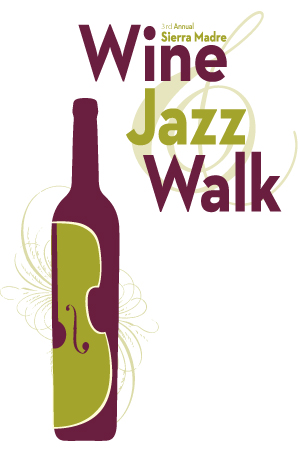 |
Sierra Madre Wine and Jazz
Walk Committee Members See Benefits of Their Work During City of Hope Tour
By Bill Coburn |
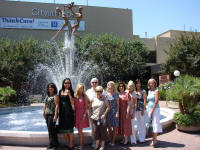 Click
photo to enlarge. The Committee photo I took was meant to include the full
fountain and the City of Hope name in the background. Below you'll see
a closer-up photo of the Committee, with me included, that City of Hope's
Steve Sommers took. Click
photo to enlarge. The Committee photo I took was meant to include the full
fountain and the City of Hope name in the background. Below you'll see
a closer-up photo of the Committee, with me included, that City of Hope's
Steve Sommers took.There's also a
photo of Dr. Richard Jove, Director of the Beckman Research Institute
addressing the committee, and a shot of construction of the new Beckman
Institute Building. |
Members of the Sierra Madre
Wine and Jazz Walk (SWJW) Committee received a mini-tour of the City of Hope
facility on Monday, June 23rd, and had an opportunity to be
de-briefed by two of the doctors that oversee where funds donated by the SMWJW
are spent. The Committee has donated $60,000 dollars to City of Hope in the two
years it has been in operation.
After being greeted by Gift
Planning Officer Steve Sommers and Sierra Madre resident Bridget Marshall of
Visitor Services, the group hopped on a tram and was shown a part of City of
Hope’s 100+ acre facility. After the brief tour, the group stepped into a
lecture room to view a presentation by Dr. Richard Jove, who wears several hats,
judging by the various titles in his curriculum vitae: Director,
Beckman Research Institute; Deputy Director, Comprehensive Cancer Center;
Co-leader, Developmental Cancer Therapeutics Program; and Professor, Division of
Molecular Medicine. His work has improved understanding of the
role of STAT3 signaling in cell growth and survival in a wide range of human
tumor cells. He has authored more than 150 scientific papers in leading research
journals.
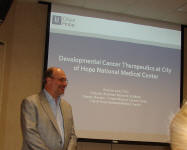 Dr.
Jove spoke about the process under which doctors operate. “You
can’t just invent something and put it into a patient, you have to have it up to
a certain standard by the FDA, and when we did that a number of years ago people
thought we were insane, the FDA said oh you can’t do that…make something like
that…and we thought we could and we did, and now we’re the gold standard, or the
platinum standard…now Harvard comes to us and says how did you do that…it allows
us to take an idea on a napkin, examine it in a petrie dish, and take it to a
mouse, and then we say to the FDA…we think we can do something with this program
of patients…we’re going to do something spectacular…”
Dr.
Jove spoke about the process under which doctors operate. “You
can’t just invent something and put it into a patient, you have to have it up to
a certain standard by the FDA, and when we did that a number of years ago people
thought we were insane, the FDA said oh you can’t do that…make something like
that…and we thought we could and we did, and now we’re the gold standard, or the
platinum standard…now Harvard comes to us and says how did you do that…it allows
us to take an idea on a napkin, examine it in a petrie dish, and take it to a
mouse, and then we say to the FDA…we think we can do something with this program
of patients…we’re going to do something spectacular…”
He discussed that one of the
goals of researchers is to reduce the toxicity of the current therapies so that
when “therapies” attack the cancer cells, they attack only those cells, reducing
the side effects that the patient experiences during their treatment.
He then discussed
the
cumulative effects of mutagenic events on cells during a patient’s lifetime,
that we are constantly bombarded by things that effect the structure of our
cells, noting that while there are cumulative effects, “the alternative is not
to live.” He discussed the STAT 3 gene, and how genes within cells can tell the
cells whether or not to “turn on” the STAT 3 cells, and how molecular medicine
research is making advances in the activation (or non-activation) of STAT 3
genes and the effect that can have in whether a cell becomes a tumor cell or
not. After his presentation, he answered questions from the committee.
Following Dr. Jove’s presentation, the Committee members were taken to the
Visitor’s Center, where a presentation was given by Dr. Michael Jensen, who
happens to be a resident of Sierra Madre. Dr. Jensen’s CV lists even more
titles than Dr. Jove’s:
Co-leader, Cancer
Immunotherapeutics Program; Associate Chair, Division of Cancer
Immunotherapeutics & Tumor Immunology; Director, Pediatric Neuro-Oncology
Program; Director, Zagoria Laboratory for Pediatric Cancer Research; Associate
Professor, Pediatrics; and Physician, Pediatric Neuro-oncology.
Dr. Jensen discussed a brain tumor (Glioma) research program
underway in which T-cells are removed from a cancer patient, “cleaned up” and
“supercharged” by adding recombinant DNA, then re-injected into the patient.
I have to admit that I was
somewhat over my head in my understanding of the above programs. While I won’t
pretend to really understand what recombinant DNA is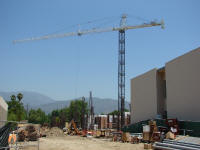 (Wikipedia definition:
Recombinant DNA is
a form of artificial DNA that is engineered through the combination or insertion
of one or more DNA strands, thereby combining DNA sequences that would not
normally occur together. In terms of genetic modification,
recombinant DNA is produced through the addition of relevant DNA into an
existing organismal genome {whole hereditary information encoded in the DNA},
such as the plasmid of bacteria, to code for or alter different traits for a
specific purpose, such as immunity,)
I will say this: the video
of the supercharged T-cells attacking and removing the cancer cells was
dramatic, and should give hope to anyone suffering from Glioma.
(Wikipedia definition:
Recombinant DNA is
a form of artificial DNA that is engineered through the combination or insertion
of one or more DNA strands, thereby combining DNA sequences that would not
normally occur together. In terms of genetic modification,
recombinant DNA is produced through the addition of relevant DNA into an
existing organismal genome {whole hereditary information encoded in the DNA},
such as the plasmid of bacteria, to code for or alter different traits for a
specific purpose, such as immunity,)
I will say this: the video
of the supercharged T-cells attacking and removing the cancer cells was
dramatic, and should give hope to anyone suffering from Glioma.
During a brief Q and A, Dr.
Jensen noted that the treatment still has to go to clinical trial via the FDA,
and that the initial non-FDA approved tests of the process were conducted on
people that had very few options, meaning that if it works on those in the worst
of shape, it probably will work for those earlier in the progression of the
disease. Dr. Jensen noted that we are on the edge of numerous breakthroughs in
medical and health technology, and that we should expect in the next few years
to see monumental changes in healthcare, due largely to the technological
breakthroughs of the last few years.
Then the conversation turned
to discussion of the recent Santa Anita fire in the hills behind Sierra Madre.
While the good doctor’s discussion of his program was informative, enlightening
and full of promise and hope, the discussion of the fire was one that everyone
in the room understood and could contribute to, based on their own experiences.
And it also localized the work that the City of Hope does. While the work done
at City of Hope benefits patients worldwide, it was especially beneficial, I
think, for the Committee members to learn not only how groundbreaking the work
being done, funded partially by the dollars donated by the community of Sierra
Madre and through their own efforts, is, but to learn that it’s being done by a
guy who shared their fear as the fire came over the ridge in April, or who is
sitting next to them at the Sierra Madre Little League game, or who is someone
they might see shopping in a local store, without any awareness that he’s the
guy making a difference for cancer patients worldwide, th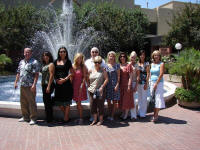 anks
to their efforts and those of their community.
anks
to their efforts and those of their community.
The committee learned a lot
about the work that their contribution was helping to fund, and was very
appreciative of the time that the doctors had taken out of their busy research
schedules to help them begin to understand why their contribution, and yours,
through your support of the Wine and Jazz Walk, is so important.
This year’s Sierra Madre
Wine and Jazz Walk is scheduled for October 25th, and will again
feature wines donated by San Antonio Winery and the Riboli Family. At least 20
local businesses will participate, with wine tasting, cuisine from local
restaurants and catering companies, raffles and a silent auction all planned.
For more information about the event, visit
www.SierraMadreWineandJazzWalk.com.

 Click
photo to enlarge. The Committee photo I took was meant to include the full
fountain and the City of Hope name in the background. Below you'll see
a closer-up photo of the Committee, with me included, that City of Hope's
Steve Sommers took.
Click
photo to enlarge. The Committee photo I took was meant to include the full
fountain and the City of Hope name in the background. Below you'll see
a closer-up photo of the Committee, with me included, that City of Hope's
Steve Sommers took.

